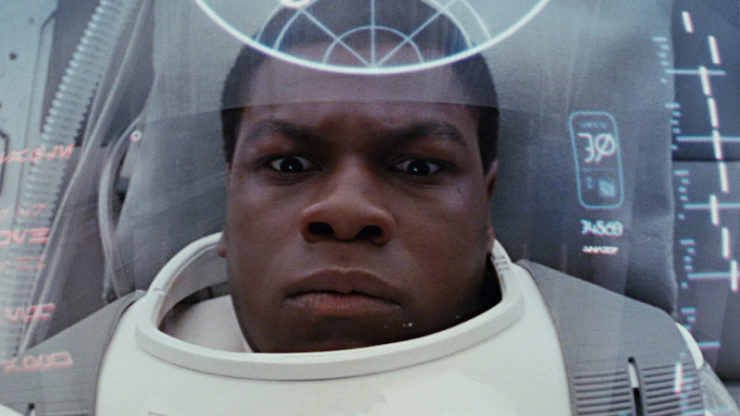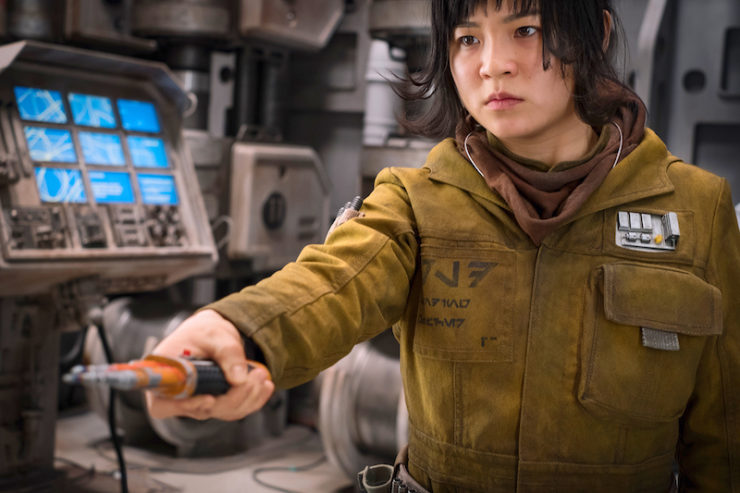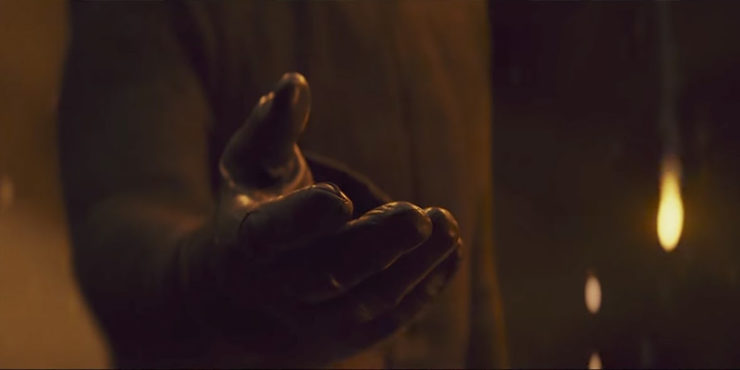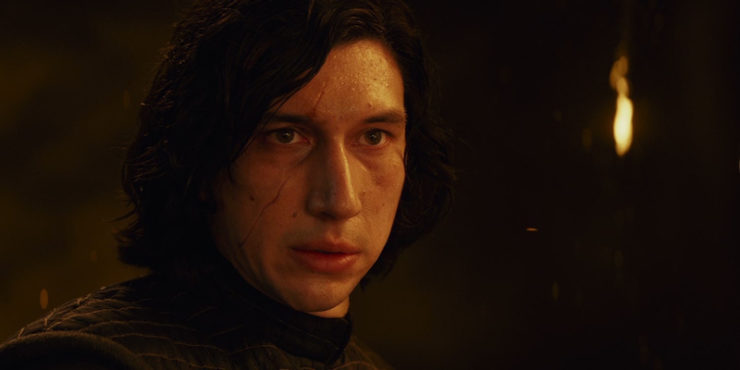The Star Wars franchise is built on running, from that first iconic shot of Tantive IV fleeing the Star Destroyer, to Artoo and Threepio climbing into an escape pod, to Luke tracking down Yoda on Dagobah. But when Finn goes for an escape pod in The Last Jedi, it’s not because he has Death Star plans and a hologram to pass into the right hands, not to search out a hidden Rebel base or a lost Jedi master—but because anywhere is better than where he’s currently standing.
For the first time in Star Wars, running is not a heroic act.
Spoilers for Star Wars: The Last Jedi.
When you’re playing Star Wars on the playground, or in your backyard, or in an MMORPG, it’s easy to be swept along toward your destiny. To board the Death Star and rescue a princess. To follow hidden maps and inspire Jedi masters to come out of hiding. To stride into the Emperor’s throne room, head held high. To embrace on the sand as the Death Star’s laser bathes your world in deafening, destroying light. You are a cog in the machine of this epic saga.
But when you’re an adult, who can see where the cogs have gotten stuck in the gears and the system is churning toward collapse, there is a shameful relief in how The Last Jedi highlights that tendency toward the denial, the selfish self-preservation. This is how a Star Wars movie speaks to its audience in 2017.

Finn is a coward through his actions.
The Resistance is literally running on its last fumes, limping pathetically through space just far enough ahead of the First Order fleet to avoid being blasted out of space. The enemy follows close behind, picking off smaller Resistance ships, shrinking the fleet with every passing hour. At the Resistance’s lowest point, Finn awakens from a medically-induced coma to confront an unprecedented level of despondency in this epic narrative. There’s no Han Solo to snarl “Never tell me the odds,” but it doesn’t matter, because they’re stacked against the Resistance anyway. The system is broken. There’s no escape for the Resistance, but there is escape for Finn—if he can spirit Rey away from this mess, if he can keep her alive, then maybe he’ll protect what he considers the galaxy’s last hope.
It’s not the admirable route. It’s not even out of character for Finn, who begged Rey to flee with him to the Outer Rim and disappear before Starkiller Base appeared over Takodana. But that was more of a fleeting urge, not unlike Han’s own considerations in both A New Hope and The Empire Strikes Back to cut and run, to attend to the price on his head rather than join the Rebellion. In both cases, the outsider is brought back in almost immediately, given a reason to care, a life to save.

Not this time. Instead, Rose Tico confronts Finn at the escape pods—cycles through awe at meeting a Resistance hero to disillusionment from his decision to flee in the same amount of time that it took her sister Paige to sacrifice herself for the Resistance. Finn doesn’t choose to rejoin the system; he is stunned and dragged back into the fight.
Amilyn Holdo is a coward through what she doesn’t say.
Or so she seems to Poe, who only knows how to run toward a problem. In his eyes, she wastes precious hours running from the First Order, with her only plan to funnel their remaining fuel into transports—to abandon ship. It’s the humiliating way out, slinking away from the battle instead of standing their ground, instead prolonging their miserable fates.

And Holdo lets him think that she’s a deserter, an unfeeling politician who doesn’t give a damn about every life sacrificed on every lagging ship blown apart in their wake. She plays to Poe’s fury because it’s more important to enact the plan, even if it leaves her looking like the villain. As Leia explains, “She cared more about saving the light than seeming heroic.” And when the time does come for running at the problem, Holdo shows him exactly how it’s done, in the film’s most arresting shot: piloting the Resistance’s flagship, revved up to lightspeed, straight through Supreme Leader Snoke’s ship The Supremacy.
Kylo Ren is a coward because he’s all talk and no action.
“It’s time to let old things die. Snoke, Skywalker, the Sith, the Jedi, the Rebels—let it all die. Rey, I want you to join me. We can rule together and bring a new order to the galaxy.”
He might as well be mouthing along to Vader’s speech from the climax of Empire, yet the context is entirely different: Kylo is not inviting Rey to be absorbed into the First Order, but rather to explode that system and rebuild something entirely new from the rubble. Like Finn, he’s finding that the system in which he operates simply isn’t working for him anymore. He’s hit his personal wall, so now he wants to break it down and see what’s actually beyond it.
The thing is, all he knows is running away. As the flashbacks reveal, Luke’s failure was not in preventing Ben Solo from falling to the dark side, but in not fighting to bring his wayward student back into the light. Convinced that Snoke has already permeated Ben’s mind and filled him with darkness, Luke turns on his lightsaber, ready to dispatch of his warped nephew. Even though the impulse passes in a moment, his resolve replaced by shame, the damage is irreparable: Ben now knows exactly what decision his uncle will make if he turns his back on the Jedi order. Yet his reaction isn’t an evil confrontation, but simply a defense: He brings up his own lightsaber to protect himself, then collapses the structure around Luke so he can escape.
Suddenly there’s a new detail in Kylo Ren’s backstory from The Force Awakens: Where before the story went that he turned on Luke, burning down the Jedi temple was not an offensive move but a defensive one—salting the earth, literally burning bridges, so as to eliminate any connections to Ben Solo. Luke had already decided that Ben was beyond saving, so why would the boy cling to that identity anymore?
“No, no—you’re still holding on. Let go!”

To be honest, I was disappointed that Rey didn’t take him up on his offer. Despite the mind bridge being Snoke’s subterfuge, it clearly illuminated to both of them how much they’re on the same wavelength: powerful Force users called to a higher purpose beyond the clashes between the First Order and the Resistance. Just as the former continues to swell in power and extend its reach, so has the latter unspooled like a fabric dropping threads. There are only tatters of the Resistance left; trying to hold on to those scraps and not just drop the whole thing is downright exhausting.
So why not watch an ambassador of the light and a devotee of the dark put their considerable powers together and try to build something entirely new? Something more balanced, perhaps, because it wouldn’t be resting on the shaky foundations of failed attempts of the past? “Failure is the greatest teacher,” Yoda tells Luke of the Jedi Order, yet no one seems willing to let the Resistance actually get snuffed out.
This partnership will never happen, not least because of this movie’s dominant imagery: the earth that cracks under Rey as she opens herself to the dark side on Ahch-To; the rock she slices in half with Luke’s lightsaber; Snoke’s ship, cleaved by glittering points of lightspeed; Luke’s saber split in two during Rey and Kylo’s tug-of-war, at the same exact point as impact. None of these fissures can be mended; there will not be a new order of the Force led by Kylo and Rey.
Despite this very clear symbolism, Rey turning down Kylo Ren is one of the movie’s most astonishingly sympathetic moments. For a beat, he looks truly lost when Rey refuses his offer to team up. He has just laid bare his own dissatisfaction with the Jedi, the Sith, the First Order, the Knights of Ren, has expressed a vulnerability in recognizing Rey as an equal, if not someone whose powers surpass his—and still Rey chooses not to join him.
Because Rey has a reason to come back. The Resistance literally needs her, as they would perish behind the rocks blocking the old Rebel base if she weren’t there to Force-lift them away and reveal the escape route. The First Order doesn’t need Kylo Ren; if he had stayed unconscious a few moments longer, Hux would have put him out of his misery. But instead of getting the chance to escape, Kylo must step back into the broken system he was so ready to abandon, and find a new place within it.
So does Finn, after some soul-searching in Canto Bight. So does Poe, after witnessing true heroism. So does Luke, by tapping back into the Force after cutting himself off from it for decades. Because it’s easy to run away. We won’t win, Rose tells Finn, by destroying the things we hate—only by saving the things that we love. The harder thing is to stay—to turn the fallen student back to the light, to carve out a new position of power, to let the hope come back to you instead of chasing after it.
But The Last Jedi will never let us forget when our heroes—and, yes, our villains—were tempted to run away from it all. And suddenly that has made it the most relatable Star Wars film.
Natalie Zutter is kinda uncomfortable with how much this movie made her sympathize with Kylo Ren. Trade Episode IX theories with her on Twitter!










